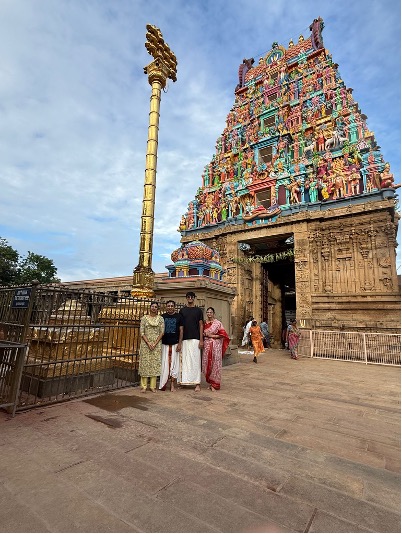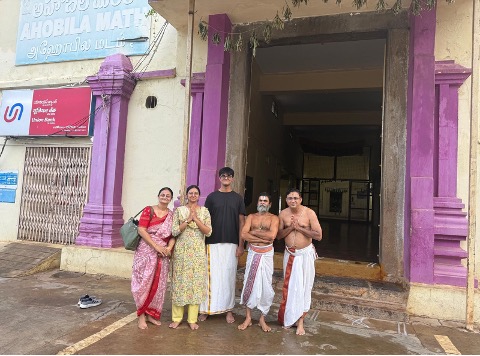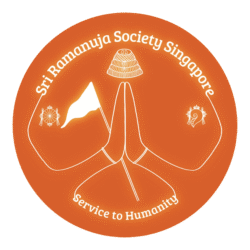By Sau. Sneha Mahesh
Ahobilam, a land of ancient temples nestled amidst vast, untamed forests, was one that had been lingering in our minds for a while. Known as a place to trek through the scenic trails with the motivation of seeing Sri Lakshmi Narasimhar in its nine different forms, it is an experience like no other. Over the years, countless family and friends had urged us to make the journey, insisting that the journey is worth every second. With their recommendations echoing in our minds, and with the divine blessings of Sri Lakshmi Narasimhar guiding our way, we finally set out to make this long-awaited journey a reality.

We planned our journey to span four days and three nights, with the aim to make the most. We started from Chennai and proceeded to Ahobilam, via Tirupati, where we planned to stay for the night. We paid a visit to Padmavathi Thayar Temple, located in lower Tirumala. The wait time was about an hour and a half, the line slowly drawing us closer to Thayar’s sannidhi. The atmosphere was filled with quiet anticipation, and as we finally stood before the goddess, a sense of calm reverence settled over us over the few seconds that we were given. As one of the wealthiest and most visited pilgrimage centres in the world, temples at Tirupati draw millions of devotees year-round, each hoping for a brief but powerful moment of darshan. Naturally, we were thrilled that the opportunity had finally come our way.
The next morning, we started at 7:00 AM to continue our journey toward Ahobilam. We reached by 11:00 AM, refreshed ourselves with a quick lunch, and by 1:00 PM, we were off again—this time, deep into the forested hills in search of the first few Narasimha sannidhis. What followed was a two-hour rocky, wild, and exhilarating jeep ride as we ascended the rugged mountain paths. Our first darshans were of Bhargava Narasimhar and Pavana Narasimhar, their altars situated deep in the forest, far away from the bustling traffic on the familiar roads. Standing there with only a few fellow devotees, the experience became profoundly peaceful, turning into a rare moment of solitude in the presence of the divine in its unique forms. On the descent, we made stops at Chatravata Narasimhar and Yoga Narasimhar. As dusk approached, we returned to our guest house, physically tired, yet spiritually energised. However, just as we thought the day had come to a close, our tour guide gently urged us to make one final stop for the day, the Prahlada Varada Temple, for the evening prayers. As we stepped into the softly lit temple, we witnessed Sri Lakshmi Narasimhar Perumal being ceremoniously put to sleep. To our delight, we were offered warm milk as prasadam, a simple yet comforting gesture that made the day’s end feel intimate and complete.
With five of the nine Narasimha shrines still to go, we welcomed the next morning with renewed energy and anticipation to finish our quest. Before we continued the last leg of our journey, we made another stop early in the morning at the Prahlada Varada Temple to seek Viswa Roopa darshan, a special ceremony to celebrate the divine’s full form.


Near this temple is Ahobilam Mattam. We stepped inside and introduced ourselves to Shri Kasturi Rangan Mama, the kind-hearted priest serving at the mattam. We shared our experience at Ahobilam so far with him, and he welcomed us warmly, happy to see our enthusiasm.

We then set out on foot to complete our quest. The trekking was a surreal feeling, as we fully immersed ourselves in the natural and spiritual landscape of Ahobilam. Trekking sticks in hand, we navigated our way across rocky paths, slippery pebbles, gentle streams, and steep stairways, singing praises of the Lord in bhajan form to uplift ourselves. One by one, we reached Kroda Narasimhar, Ahobila Narasimhar, Karanja Narasimhar, and Malola Narasimhar—each with its own fierce yet divine form. Along the way, perched on a small arched rock, we came across the sannidhi of Sri Ramanuja. A quiet moment was spent offering our respects to the revered saint.


The final and most intense stretch of our hike led us to Jwala Narasimhar, dramatically positioned near a cleft in the mountain believed to be the very site where Lord Narasimha emerged from the pillar to slay the demon Hiranyakashipu. As we neared the shrine, water that gently trickled down from the stambham (pillar) above showered down on us like a divine blessing.
Beside the temple lay a small pond known as Raktha Kunda, where tradition holds that the Lord washed the blood from His hands after the battle. The water, still bearing a faint reddish hue, stood as a powerful symbol of both wrath and mercy. Like many devotees before us, we carefully collected a small amount to take home as a sacred memento of a journey.
Our journey to Ahobilam became a powerful moment of devotion, nature, discovery, and grace. Every part reminded us of the deep spiritual history woven into our landscapes. Whether it was the thrill of scaling forested hills in search of the Nava Narasimhars or the quiet peace of receiving Vishwa Roopa darshan under the nearly morning sky, each moment left an imprint on our hearts. Feeling spiritually fulfilled and content from our adventure, we began our journey back to Chennai. Indeed this trip got us saying— “Aho Bila, Aho Bala!” (“Great Cave, Great Strength!”)



No responses yet